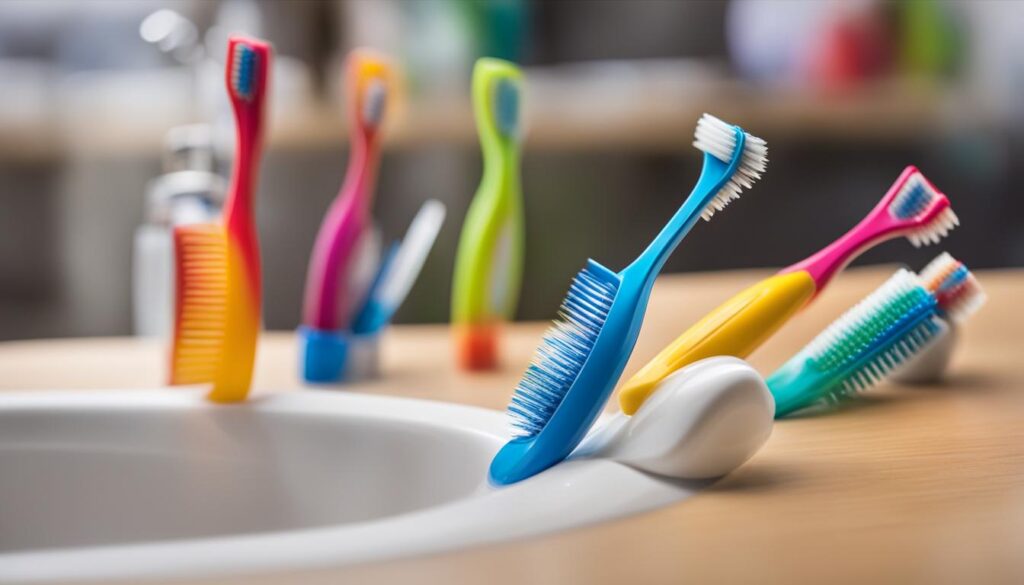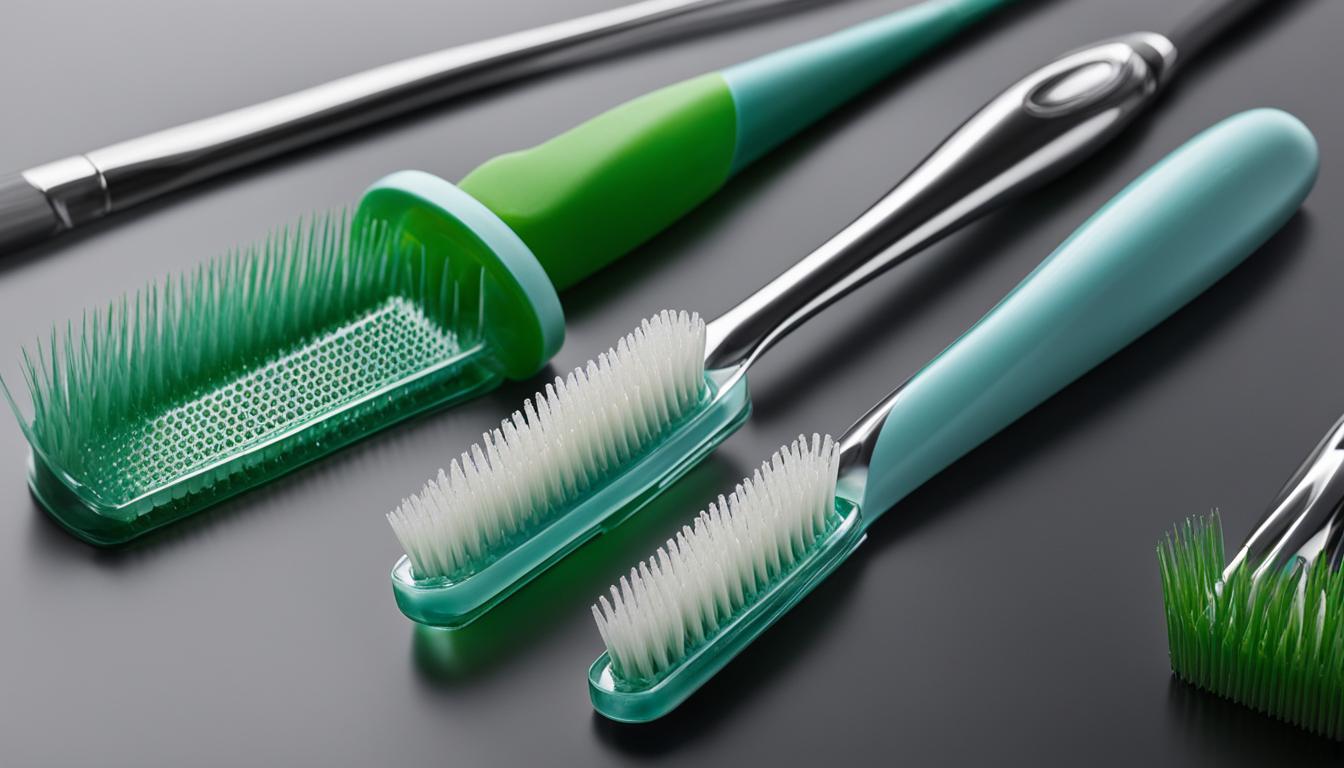Choosing the right toothbrush can make a significant difference in your oral health, especially if you are dealing with periodontal disease. This article will help you understand which features make a toothbrush suited for combating gum disease, and how you can make the most informed decision when selecting the best toothbrush for gum disease. To better understand how toothbrush designs and modes affect periodontal health, let’s delve into the world of electric and manual brushes, features to look out for, and how to properly address periodontal disease toothbrush requirements.
Contents
- 1 Understanding Periodontal Disease and Oral Hygiene
- 2 The Efficacy of Electric Toothbrushes for Gum Health
- 3 Optimal Toothbrush Traits for Managing Periodontal Disease
- 4 Comparing Electric Toothbrush Varieties: Oscillating-Rotating vs. Sonic
- 5 Manual vs. Electric Toothbrushes: What You Need to Know
- 6 Conclusion
- 7 FAQ
- 7.1 What causes periodontal disease?
- 7.2 How important is effective plaque removal for periodontal disease prevention?
- 7.3 What key features should a toothbrush for periodontal disease have?
- 7.4 How do electric toothbrushes fare in improving gum health?
- 7.5 What are the optimal toothbrush traits for managing periodontal disease?
- 7.6 Can you compare the benefits of oscillating-rotating and sonic toothbrushes for managing periodontal disease?
- 7.7 What does the American Dental Association recommend regarding toothbrushes for periodontal disease?
- 8 Source Links
Key Takeaways
- Electric toothbrushes often provide better plaque removal and gum health improvement when compared to manual brushes
- Features to consider in a toothbrush for periodontal disease: pressure sensor, soft brush heads, timer, and a small head for reaching back teeth
- Proper brushing technique is just as important as the choice of toothbrush
- Achieving the best balance of cost and efficiency is crucial while selecting a toothbrush for periodontal health
- Select a toothbrush that meets American Dental Association recommendations for optimal performance
Understanding Periodontal Disease and Oral Hygiene
What Causes Periodontal Disease?
Periodontal disease, also known as gum disease, is primarily caused by plaque buildup. This sticky film accumulates on your teeth and, if not removed daily, can harden into tartar. When plaque and tartar are left untreated, they can inflame and irritate your gums, leading to gingivitis, the initial stage of gum disease. If gingivitis is not properly managed and treated, it can progress into periodontitis, ultimately resulting in tooth loss and damage to the surrounding bone and tissue.
The Importance of Effective Plaque Removal
Daily brushing is crucial for removing plaque and preventing tooth decay from occurring. Effective plaque removal is necessary to prevent plaque buildup from turning into tartar, as tarwe can contribute to the development of gum disease. Proper brushing should reach all areas of the mouth, including the gum line, to address plaque accumulation and ensure optimal oral health. In addition to regular brushing, it is essential to incorporate flossing into your oral hygiene routine to target hard-to-reach areas between your teeth.
Key Features of a Periodontal Disease-Friendly Toothbrush
When selecting a toothbrush for periodontal disease prevention and treatment, there are a few essential features to consider:
- Pressure sensor: A toothbrush with a pressure sensor can alert you when excessive pressure is applied during brushing, thus helping prevent damage to your gums and teeth from hard brushing.
- Soft bristles: Opt for a toothbrush with soft bristles, which minimize gum irritation while effectively removing plaque.
- Small head size: A toothbrush with a small head will allow you to reach hard-to-reach areas, such as the back teeth, ensuring a thorough clean for all areas of your mouth.
By considering these features when selecting a periodontal toothbrush or a gum disease toothbrush, you can ensure that your oral hygiene routine is tailored to preventing and managing periodontal disease.
“Taking the time to choose the right toothbrush for your oral health needs is an important investment in your long-term dental well-being.”
The Efficacy of Electric Toothbrushes for Gum Health
Electric toothbrushes have proven to be highly effective at not only cleaning teeth but also at maintaining and improving gum health. When compared to their manual counterparts, they provide a gentler cleaning experience that stimulates blood flow and promotes healthy gum tissue. Additionally, electric toothbrushes are known to reduce inflammation and remove more plaque, which is crucial for preventing the progression of gum disease, especially in individuals with receding gums.
“Using an electric toothbrush can make a real difference in your oral health, particularly for individuals with receding gums or those susceptible to gum disease.”
One of the key factors that contribute to the enhanced efficacy of an electric toothbrush for receding gums is the wide range of features and technologies these devices possess. For instance:
- Various cleaning modes cater to different oral health needs, including sensitive and gum care modes that ensure gentle cleaning while targeting problematic areas.
- Smart sensors may adjust brushing intensity to avoid applying excessive pressure, which can exacerbate gum recession.
- Timers and quad pacers provide guidance to ensure a thorough and consistent brushing routine for the recommended duration.
These features work in tandem to provide a comprehensive and effective oral hygiene routine, ultimately leading to better overall gum health.
| Benefits of Electric Toothbrushes for Gum Health |
|---|
| Stimulates blood flow to promote healthy gum tissue |
| Gentle cleaning reduces inflammation and prevents gum injury |
| Removes more plaque than manual brushes, reducing the risk of gum disease progression |
| Various cleaning modes and smart sensors accommodate individual oral health needs |
| Timers and pacers ensure thorough and consistent brushing for optimal gum health |
In conclusion, electric toothbrushes offer significant advantages for individuals looking to improve their gum health and combat receding gums. With a host of features designed to provide gentle yet effective cleaning, these devices represent a worthwhile investment in promoting long-term oral health. So, if you’re concerned about your gum health, it’s worth considering an electric toothbrush for receding gums to give your oral hygiene routine a much-needed boost.
Optimal Toothbrush Traits for Managing Periodontal Disease
Choosing the best toothbrush for receding gums and periodontal disease requires considering features specifically designed to address the unique challenges faced by those with gum issues. To effectively manage gum disease, it is essential to select a toothbrush equipped with a pressure sensor, soft bristles, and suitable brush head design. Additionally, multiple cleaning modes, including sensitive and gum care, can make a significant difference in overall gum health.
Pressure Sensor and Gum Care Technology
A toothbrush with pressure sensor is crucial for individuals with periodontal disease, as applying excess pressure during brushing can worsen gum recession. Advanced toothbrushes on the market offer smart sensors that automatically adjust brushing intensity, ensuring gentle yet effective plaque removal without causing further damage to delicate gum tissue.
“A pressure sensor is crucial for individuals with periodontal disease, as applying excess pressure during brushing can worsen gum recession.”
Brush Head Design: Size and Softness
Those with periodontal issues should opt for a soft bristles toothbrush as it effectively cleans the teeth and gums without causing unnecessary irritation. Using a toothbrush head design for periodontitis with a smaller size is necessary for reaching all areas of the mouth, including around the molars. This ensures thorough cleaning, reducing the risk of plaque buildup and the progression of gum disease.
- Soft bristle toothbrush for gentle cleaning
- Small brush head for better reach
Additional Cleaning Modes and Their Benefits
Selecting a multiple cleaning modes toothbrush allows for customization of daily oral hygiene routines, catering to the unique needs of those with gum disease. A sensitive mode is beneficial for individuals experiencing discomfort during brushing, while gum care technology provides targeted treatment for problematic areas.
| Cleaning Mode | Benefits |
|---|---|
| Sensitive Mode | Extra gentle cleaning for sensitive gums |
| Gum Care Mode | Targeted treatment for problematic gum areas |
To conclude, finding the right periodontal disease toothbrush involves selecting one with a pressure sensor, suitable brush head design with soft bristles, and multiple cleaning modes. These features work together to provide gentle, effective cleaning and promote overall gum health.
Comparing Electric Toothbrush Varieties: Oscillating-Rotating vs. Sonic

When it comes to electric toothbrushes, there are two primary types: the oscillating-rotating and the sonic toothbrushes. Both types offer advantages in the fight against gum disease, catering to varying user preferences and periodontal health needs. This section provides a comparison of these two electric toothbrush technologies to determine the ideal choice for maintaining optimal periodontal health.
How Oscillating-Rotating Models Benefit Periodontal Health
An oscillating-rotating toothbrush features a small, round brush head that rotates and effectively cleans tooth surfaces. A popular example of oscillating-rotating technology is the Oral-B rotating toothbrush. Dental professionals often endorse oscillating-rotating models due to their ability to provide precise cleaning without exerting excessive pressure on teeth and gum tissues. This gentle approach helps reduce the risk of further gum recession and inflammation, crucial factors in maintaining periodontal health.
The Advantages of Sonic Toothbrushes in Gum Disease Prevention
On the other hand, sonic toothbrushes use high-frequency vibrations to create a dynamic cleaning action. These vibrations effectively break up plaque and aid in interdental cleaning. Sonic toothbrushes have been praised for their benefits in preventing gum disease with sonic technology, offering a faster and more efficient way of cleaning teeth when compared to manual toothbrushes.
While some studies have shown oscillating-rotating toothbrushes to be marginally more effective in certain cases, sonic toothbrushes remain a superior choice over manual toothbrushes. Choosing between oscillating-rotating and sonic toothbrush technologies ultimately comes down to personal preference and comfort.
In conclusion, both oscillating-rotating and sonic toothbrushes offer unique benefits to periodontal health. The choice between the two will depend on your individual needs and preferences. Either way, incorporating one of these electric toothbrush technologies into your oral care routine will significantly improve your gum health.
Manual vs. Electric Toothbrushes: What You Need to Know
When it comes to maintaining oral health, choosing the right toothbrush is crucial. In this section, we delve deeper into two types of toothbrushes: manual and electric, discussing their cost and accessibility, as well as the American Dental Association’s recommendations for each.
Cost and Accessibility
One of the primary concerns for many people when selecting a toothbrush is the cost. Manual toothbrushes are generally more cost-effective and easily accessible, appealing to a wider range of budgets. However, long-term studies have shown that electric toothbrush users tend to experience less gum recession and tooth decay, indicating that although electric toothbrushes may require a more significant initial investment, the overall benefits for periodontal health are notable.
The benefits of electric toothbrushes for periodontal health are notable, despite the higher initial cost compared to manual toothbrushes.
Exploring the American Dental Association’s Recommendations
The American Dental Association (ADA) recommends soft-bristled brushes – both manual and electric – to prevent damage to gums and enamel, with evidence against sharp or jagged edges on bristles. The ADA has stated that both manual and electric toothbrushes can be effective in plaque removal, but the key lies in using the proper brushing technique. However, it is essential to choose an ADA-approved toothbrush to ensure the highest level of effectiveness in maintaining oral health.
Here are some ADA recommendations for selecting the right toothbrush:
- Select a toothbrush with soft bristles to minimize gum irritation
- Look for an ADA-approved toothbrush, as these undergo rigorous quality control testing
- Replace your toothbrush at least every three to four months, or when the bristles become frayed
In conclusion, although manual toothbrushes are more affordable and accessible, studies have demonstrated the advantages of electric toothbrushes for periodontal health. The choice ultimately depends on personal preference and budget, but it is crucial to select an ADA-approved toothbrush and follow proper brushing techniques to ensure optimal oral hygiene.
Conclusion
Preventing gum disease relies significantly on choosing the right toothbrush for periodontal disease and using it effectively. The ideal toothbrush must combine several features, such as soft bristles, a small head for improved reach, a pressure sensor, and various cleaning modes. Regular dentist visits, adherence to their recommendations, and an appropriate brushing routine are crucial for preventing and managing periodontal disease.
While both manual and electric toothbrushes can be effective for periodontal health, research has shown that electric toothbrushes provide advantages in maintaining gum health. They are gentle on gums and help remove more plaque compared to manual toothbrushes, which is essential for managing periodontal disease.
When selecting a toothbrush, prioritize the features tailored for gum disease prevention, rather than focusing solely on the cost. Your oral health is a vital aspect of your overall well-being, and investing in an effective toothbrush that caters to your specific needs will be beneficial in the long run.
FAQ
What causes periodontal disease?
Plaque buildup is a key cause of periodontal disease. If it’s not regularly removed, it can harden into tartar, leading to gum disease. Gingivitis, the initial stage of gum disease, can advance to periodontitis if left untreated, resulting in tooth loss.
How important is effective plaque removal for periodontal disease prevention?
Effective plaque removal is crucial for preventing periodontal disease. Daily brushing helps remove plaque and prevent it from turning into tartar, which contributes to gum disease. Proper brushing reaches all areas of the mouth, including the gum line, to address plaque accumulation.
What key features should a toothbrush for periodontal disease have?
A toothbrush for periodontal disease should have a pressure sensor to avoid hard brushing, soft brush heads for a gentle yet effective clean, a timer to ensure the recommended brushing duration, and a small head for reaching hard-to-reach areas like the back teeth.
How do electric toothbrushes fare in improving gum health?
Electric toothbrushes provide superior plaque removal and gum health improvement when compared to manual brushes. They are gentle on the gums and have been proven to reduce inflammation and remove more plaque, crucial for preventing the progression of gum disease.
What are the optimal toothbrush traits for managing periodontal disease?
The ideal toothbrush should have a pressure sensor that signals if you are brushing too hard, soft-bristled head for gentle cleaning, a small head for cleaning hard-to-reach areas, and various cleaning modes like sensitive and gum care modes for targeted care of sensitive gums and problematic areas.
Can you compare the benefits of oscillating-rotating and sonic toothbrushes for managing periodontal disease?
Oscillating-rotating toothbrushes are endorsed by dental professionals for their precise cleaning capabilities without exerting unnecessary pressure, reducing the risk of further gum recession and inflammation. Sonic toothbrushes operate with high-frequency vibrations aiding interdental cleaning by breaking up plaque. Though studies have shown rotating-oscillating models to be slightly more effective in some cases, sonic toothbrushes are still an excellent choice and are ultimately a matter of personal preference.
What does the American Dental Association recommend regarding toothbrushes for periodontal disease?
The ADA recommends soft-bristled brushes to prevent damage to gums and enamel, with evidence against sharp or jagged edges on bristles. The association has stated that both manual and electric toothbrushes can be effective in plaque removal, highlighting the importance of proper brushing technique.





Leave a Reply